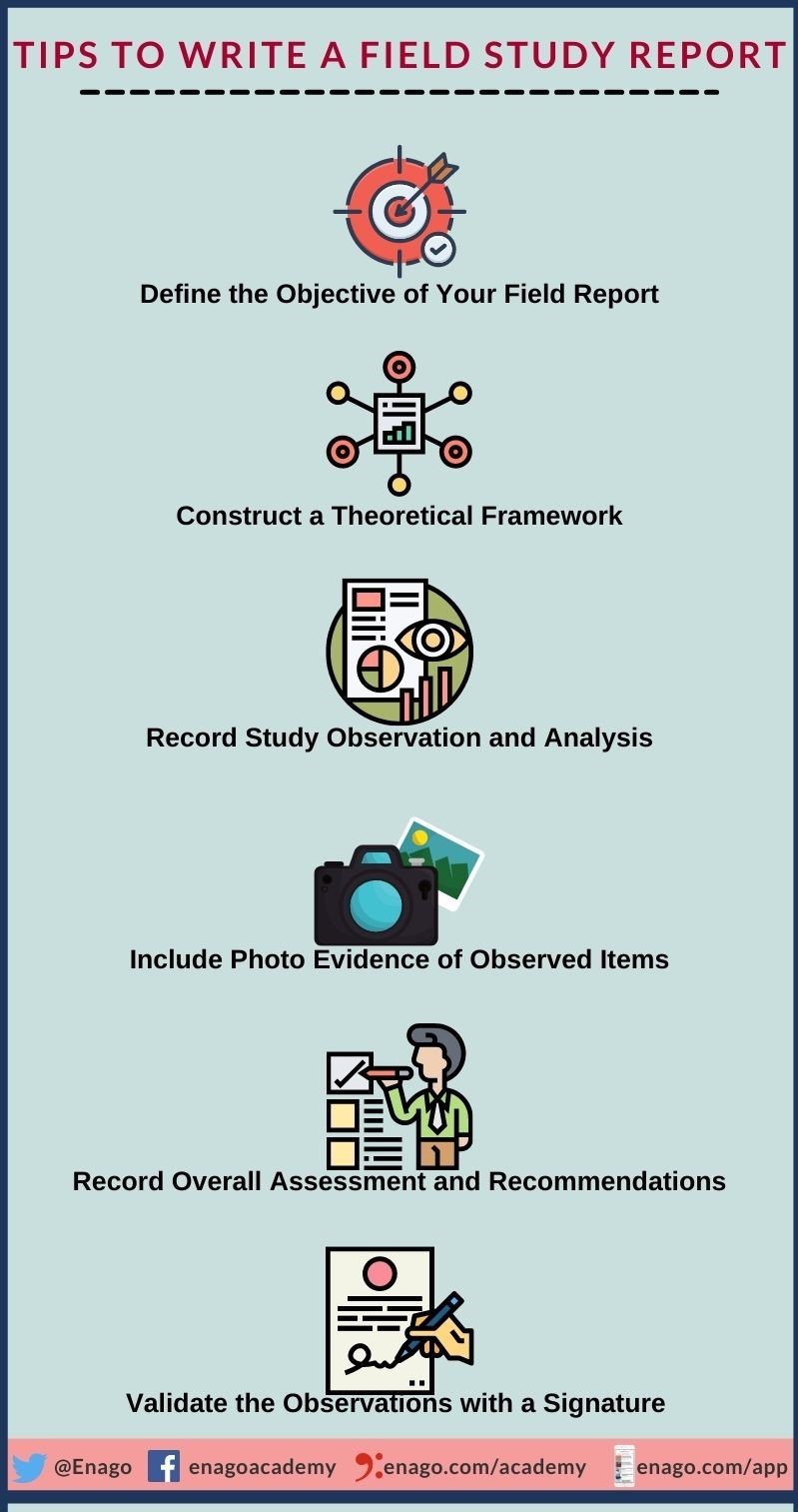Want to Write a Field Study Report? 6 Key Points to Consider!

Research conduction is not just limited to your laboratory, library, or work place setting. As part of your research you may have to step out in the field (any place other than your regular research lab or work station) to collect raw data for analysis and then publish it as a field study report. In this article, we will discuss the elements of a field study report and the key points to consider while writing one!
What is a Field Study Report?
A field study report is defined as a documentation of analysis of particular phenomena, behaviors, processes based on theories and observations made by the researcher in the field. These observed and analyzed theories are used to identify solutions for a specific project or case report.
What is the Importance of Field Study Report?
- A field study report is important as part of many operational and technical documentation processes in various industries including field services, education, medicine, and management.
- Moreover, it gives detailed information of an observed subject or specimen which is used to analyze and compare data against a theoretical framework.
- It also helps in identifying challenges in implementing solutions to form a standardized protocol.
- Furthermore, it helps in capturing information on resource management and discovering new processes for effective and optimized solutions.
How to Write Field Research Notes?
A field study report begins with an idea and ends with a solution. Hence, while conducting field research, one must follow a planned route of taking notes for proper documentation of the observations made. A successful field study report begins when the researcher is involved in the observational research process of taking proper notes.
Based on the methods, the field research notes are categorized in four different types:
1. Job Notes:
- Researchers use this method of taking field notes whilst they are conducting the study.
- These notes are taken in close proximity and in open sight with the study’s subject.
- These notes are brief, concise, in the form that can be built on by the researcher later while creating the report.
2. Field Notes Proper:
- This method of taking field notes is to expand them immediately after the completion of study.
- These notes are detailed and the words have to be as close to the terms that will be used in the final field study report.
3. Methodological Notes:
- This type of field notes involve research methods used by the researcher, newly proposed research methods, and the way to monitor their progress.
- Methodological notes are either attached with field notes or filed separately. These notes are always placed at the end of the field study report.
4. Journals and Diaries:
- This method of taking notes is an insight into the researcher’s life as it tracks all aspects of the researcher’s life.
- It helps in eliminating any bias that may have affected the field research.
Examples of Things to Document During Field Study
1. Physical Setting:
Observe the characteristics of the space where the study is being conducted.
2. Objects and Material:
The presence, placement, and arrangement of objects that affect the behavior of the subject being studied.
3. Language Used:
Observe the language being used by study participants (in case of human participation).
4. Behavior Cycles:
Document who is performing what behavior at what time and situation.
5. Physical Characteristics of Participants/Subjects:
Observe and note personal characteristics of subjects.
6. Body Movements:
Things such as body posture or facial expressions and assess if these movements support or contradict the language used while communicating.
Data Collection in Field Report (Sampling Techniques)
Data collection process in field study is also known as sampling. It refers to the process used to select a portion of the population for study. Selection of an ideal sampling technique is imperative to obtain the richest possible source of information to answer the research questions.
Different Types of Sampling Techniques:
Ad Libitum Sampling
This technique involves observing whatever seems interesting at the moment. It does not follow an organized system of recording the observations.
Behavior Sampling
This sampling technique involves watching the entire group of subjects and recording each occurrence of a specific behavior of interest with reference to which individuals were involved.
Continuous Recording
This sampling technique includes recording of frequencies, durations, and latencies in a continuous and systematic pattern.
Focal Sampling
The focal sampling technique involves observing one individual/subject for a specified amount of time and recording all instances of that individual’s behavior.
Instantaneous Sampling
The technique of instantaneous sampling involves dividing observation sessions into short intervals by sample points.
One-Zero Sampling
The one-zero sampling technique is similar to instantaneous sampling. It involves recording only if the behaviors of interest have occurred at any time during an interval instead of at the instant of the sampling point.
Scan Sampling
The scan sampling technique involves taking a census of the entire observed group at predetermined time periods and recording what each individual is doing at that moment.
What is the Structure and Writing Style of Field Study Report?
A field study report does not have a standard format; however, the following factors determined its structure and writing style:
- Nature of research problem
- Theoretical perspective that drives the analysis
- Observations made by researcher
- Specific guidelines established by your professor/supervisor
A field study report includes 6 main elements as follows:
1. Introduction
The introduction section should describe the objective and important theories or concepts underpinning your field study. More importantly, it should describe the organization’s nature or setting where you are conducting the observation—the types of observations conducted, the focus of your research study, what was observed, and which methods were used for collecting the data. Furthermore, it is important to include a review of pertinent literature.
2. Description of Activities
It becomes imperative for researchers to provide the information to the readers about what happened during the field study. Hence, you must include the details of all events that take place during your field research.
The description section helps in answering the five “WH” questions as mentioned below:
- What:
What did you see and hear in your area of study?
- Where:
Where does the background information of the research setting is observed and reported?
- Why:
Why are you conducting this field research?,
The reason behind particular thing happening , and
Why have you included or excluded specific information?
- Who:
Who are the participants in terms of gender, age, ethnicity, and other relevant variables from your observation?
- When:
When is the study being conducted (day or time when occurring actions are observed and noted)?
3. Analysis and Interpretation
While you are on the field conducting the study, you are likely to observe multiple things. However, it is up to you as to which observations do you want to interpret and record in the report. This allows you to show the reader that you are interpreting events like an informed observer. Furthermore, your theoretical framework helps you in making this decision. The analysis and interpretation of your field observations must always be placed in the larger context of the theories described in the introduction.
Some questions to ask yourself when analyzing your observations are as follows:
- What is the meaning of your observations?
- What are the reasons behind the occurrence of the things you observed?
- How typical or widespread are the events and behaviors of the things you observed?
- Are there any connections or patterns in your observations?
- What are the implications of your observations?
- Did your observations match the objective of your study?
- What were the merits of your observations?
- What were the strengths and weaknesses of your recorded observations?
- Are there any connections between your findings and the findings from pertinent literature?
- Do your observations fit into the larger context of the study’s theories?
4. Conclusion and Recommendations
The conclusion of your field study report should summarize your report and emphasize the importance of your observations. This section has to be concise and relevant to your field study and must not include any new information. Furthermore, it is imperative to highlight any recommendations that you may have for readers to consider while conducting similar study. Additionally, describe any unanticipated problems you encountered and note the limitations of your study. Limit your conclusion to around two to three paragraphs.
5. References
The reference section must include every source that you referred to and used while writing your field study report. Since format for writing references may differ for every university, you must consult your professor to understand the format and write it accordingly.
6. Appendix
This section includes information that is not essential to explain your findings, but supports your analysis [especially repetitive or lengthy information]. It validates your conclusions and contextualize a related point. This helps the reader to understand the overall field study report.
6 Key Points to Consider While Writing a Field Study Report
A field study report focuses on factual and observational details of a project case. It must help the reader understand how theory applies to real-world scenarios. Hence, it should cover the circumstances and contributing factors to derive conclusive results from the observed and collated raw data.
Below are the key points to consider while writing a field study report:

1. Define the Objective of Your Field Report
- Ensure that you state the purpose of your field study report clearly.
- Determine the focus of your study and provide the relevant information.
- Define the setting of observations, and the methods used to collect data.
2. Construct a Theoretical Framework
- Creating a theoretical framework helps you in garnering information based on statistics, news, and pertinent literature for better understanding.
- Additionally, it guides you in determining the data that need to be analyzed and set as a baseline for comparison to acquire necessary information.
3. Record Study Observations and Analysis
- Take notes of your observations based on the defined scope of work (SOW).
- Furthermore, achieve and record the detailed plan on how to achieve the set objectives.
4. Include Photo Evidence of Observed Items
- Validate gathered raw data with photographs or videos as evidences.
- This increases the authenticity of your report and the conclusions you derive from it.
5. Record Overall Assessment and Recommendations
- Document all the observed aspects of your study based on gathered analysis and observations.
- Furthermore, clearly explain the observations and discuss the challenges and limitations faced by you while conducting the study.
6. Validate the Observations with a Signature
- After completing your research and documenting it, it is important to declare who is responsible for the reported data.
- Additionally, you must validate your findings in the field study report by signing off with a digital signature at the end of the report.
Did you every try writing a field study report? How difficult or easy was it? What methods do you follow while writing a field report? Let us know about it in the comments section below!










very well written….the enumeration is really commendable dear Bhosale…sweet regards from Nepal..
Very well explained and detailed. The information was relevant to my research. thanks
Wow…. Thank you I find this useful 🙏